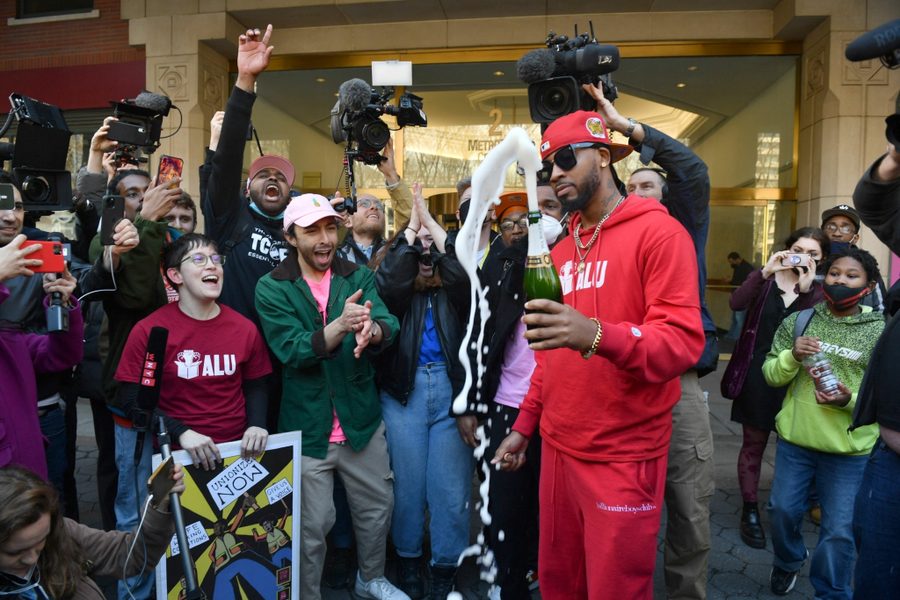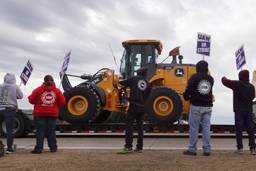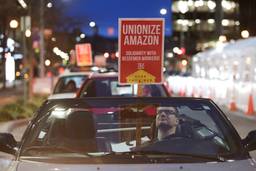The Amazon Union Campaign Won By Following the Lead of Workers
Amazon Labor Union shows us an essential ingredient of successful union campaigns: democratic autonomy.
Shaun Richman

Jeff Bezos has been brought back down to Earth. No boss is invincible. The workers at Staten Island’s JFK8 Amazon fulfillment center proved it by beating the massively rich and powerful corporation 2,654 to 2,131 in a National Labor Relations Board (NLRB) election on April 1. Meanwhile, a rerun election campaign by the Retail, Wholesale and Department Store Union (RWDSU) at Amazon’s Bessemer, Ala. facility remains too close to call when challenged ballots are considered. That the workers in Staten Island organized themselves into an independent Amazon Labor Union (ALU) is profoundly heartening and begs for some introspection from labor leaders and organizing directors. Maybe, just maybe, workers are ready to organize on a massive scale. What are existing unions doing to make the most of the moment?
One of the first lessons from JFK8 is that the workers did a pretty good job of organizing themselves. It was a worker-led movement with a leadership group that sought out the existing workplace leaders (co-workers who are respected, trusted and listened to). They read books, they had worker-to-worker conversations, and they engaged in job actions and demonstrations to cut through some of the fear. They were transparent about their aims, built trust and kept themselves accountable to each other. This is pretty basic stuff, but far too many unions cut corners to get a quick election before the boss can chip away too much support, instead of organizing for a long-haul struggle. We have decades worth of scientific research about effective organizing model tactics, yet too many union organizing directors still justify their campaigns as exceptions to the rules. This goes a long way to explain why the workers in Staten Island and in many other parts of the country have chosen to go it alone.
I’ll be honest. I didn’t think ALU would win their NLRB election. The rigged rules of union certification campaigns, permitting bosses to spend hundreds of thousands (if not millions) of dollars on 24/7 campaigns of psy-ops, lies, threats, targeted harassment and retaliation are too stacked against workers to typically win the high-stakes, winner-take-all elections. This is the main reason why while 68% of the public supports unions, and half of all workers say they would vote for a union tomorrow, private sector union density hovers at around 7%. (I’ve been encouraging Amazon workers who are organizing elsewhere to consider filing for minority union certifications to win themselves a form of meet-and-confer recognition and build from there.)
Partly, what makes boss campaigns successful is that they tap into fear of the unknown, and what comes the day after an NLRB election is a huge unknown for too many workers. Bosses will threaten that everything you like about the job could be bargained away, or that nothing will change unless the union “makes” you go on strike, and that if you go on strike you could lose your job. The fear they’re stoking is not only of their own dictatorial power, but also the fear of losing agency to the authority of a new boss — the “union boss.” The workers at JFK8, all on their own, could turn to each other and state the obvious: “How the hell am I going to make you strike? We can only go on strike if enough of us agree that it’s necessary and its time has come.” Mind you, this is true of any union and any organized workplace, but too many union campaigns don’t address this crucial piece of inoculation by centering the workers’ own agency in such a life-or-death decision. Similarly, too many unions don’t build bargaining and representation decisions into their new organizing campaigns, despite the research that shows that building for the first contract through surveys, meetings and other democratic practices—before the election — is one of the 10 union tactics most correlated with NLRB election wins.
Some people may look at the success of ALU, and at the continuing frustrations of RWDSU’s efforts in Bessemer, and draw the conclusion that organizing independently of the established unions is a key to success. That would be a mistake. Only a major international union can muster the resources to take on Amazon across the continent and win a coast-to-coast union contract covering workers at all fulfillment centers. I may be confirming my priors, but the victory on Staten Island does provide an argument that unions need to be way more open to chartering new locals for new union organizing campaigns.
I’ve argued that labor’s ambitious “organize or die” era (basically, from the election of John Sweeney in 1995 until Change to Win petered out about a decade ago) was frustrated by institutional tensions that went unaddressed. International unions have an existential need to organize new industries and employers. But in order to maximize financial resources, most unions tried to organize new members into their existing locals, where leaders have very different motivations: namely, to win good contracts for, and be re-elected by, the existing union members that they know. Those tensions led to a lot of good campaigns getting spiked because of internal disagreements and political sabotage. Workers pick up on these tensions, and it adds unhelpful noise to a campaign. Workers want to know where their contract priorities and workplace leaders will fit within a union whose bread and butter has been, say, UPS drivers or workers at Macy’s department store. No existing international union — not the RWDSU nor the Teamsters nor even the UAW if they decide the “A” stands for “Amazon” — will successfully organize the workers at Amazon or any other large anti-union company without guaranteeing the workers a significant degree of democratic autonomy and agenda-setting on the front-end.
I keep thumping on the organizing model, but the truth is that it badly needs reevaluating in a way that hasn’t been done since the 1990s. Then, the AFL-CIO under the new leadership of John Sweeney initiated a thorough look at the priorities and practices of union organizing. Academics and labor educators were engaged, research reports were commissioned, left-wing organizers who were shunned during the Lane Kirkland years were put on payroll and contributed to the so-called “theory of the win,” new organizing training were developed, and strategic corporate research departments were staffed up. Although the unions that take organizing seriously have learned, evolved and added to their best practices, some of the unspoken assumptions from that long-ago era that undergird the organizing model need to be reconsidered. In particular, we need to question the assumption that the boss can and will fire workers and launch a reign of terror (still true, but); that no one in power will stop them or care; that it will have a chilling effect on the workers striving to win a union for themselves; and that support for a union drive can only decline after going public — assumptions that default to a limited number of staff-driven campaigns organized in secret. It would be wonderful if the AFL-CIO again took leadership and convened an all-stakeholders review of what we’ve learned and what’s happening in worker attitudes to develop effective union organizing strategies two decades into this new century.
Shaun Richman is a labor expert at SUNY Empire State College and author of Tell The Bosses We’re Coming: A New Action Plan for Workers in the 21st Century.







